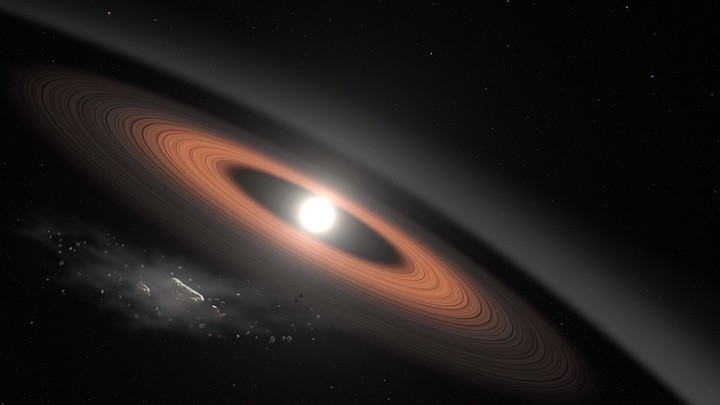1.11.2020

Scientists studying how comets and asteroids break up and vaporize if they get too close to their suns have resolved a conundrum about a class of stars known as white dwarfs.
Embers of dying suns, white dwarfs form when a star, having run out of its nuclear fuel, first expands to enormous size then collapses into a dense, Earth-sized remnant.
The initial, swollen size is called a red giant – and is large enough to consume planets as far out as Earth, and even Mars. It then implodes, leaving the white dwarf, which can initially be as hot as 50,000 degrees Celsius, until it gradually cools into obscurity.
So far, so good. But astronomers have found that about 4% of them appear to be accompanied by clouds of dust.
“This begs the question, if white dwarfs should have cleared out all of this debris during the red giant phase, then why do some of them seem to have closely orbiting dusty debris discs,” Jordan Steckloff, of the Planetary Science Institute, US, told this week’s virtual meeting of the American Astronomical Society’s Division for Planetary Sciences.
Previously, he says, it was assumed that these discs were formed from planetesimals or asteroids that were far enough out to survive immolation in the red giant phase, but then fell inward, winding up so deep in the white dwarf’s gravity that they got ripped to shreds—something that occurs at a distance often referred to as the Roche limit.
These shreds would then be dispersed into a “nice tight dusty debris disc” by the pressure of the light emitted by the star.
But there was a big problem with that theory. One would expect younger white dwarfs to have less stable planetary systems, thanks to the gravitational mayhem that accompanied the effect of the red giant destroying all of the inner planets. In other words, they should have more worldlets falling toward the star to be ripped into dust.
Also, younger white dwarfs are hotter – and therefore brighter – and should be better at making dusty discs out of the debris of shredded planetesimals.
But that, Steckloff says, is not what astronomers have seen. Young super-hot white dwarfs do not have dust disks. “It’s only when white dwarfs cool to less than about 27,000 degrees Kelvin (27,000°C) that we actually see dusty debris discs start to appear.”
The answer, he says, is something fairly obvious (in hindsight) but previously overlooked: if a planetesimal falls too close to a super-hot star, not only will it get shredded into dust, that dust will then be vaporized by the heat – a process he refers to as sublimation. The result: no dusty disc.
“It needs to be outside the sublimation limit and inside the Roche limit,” he says.
The Roche limit is determined by the star’s mass, but the sublimation limit is determined by its brightness, which declines as it cools.
And, he says, it turns out that for young, super-hot white dwarfs, the Roche limit is inside the sublimation limit. I.e., anything that falls close enough to the star to be shredded will also be vaporized.
It is only when the white dwarf cools to somewhere between 25,000 and 32,000 Celsius, he says, that this reverses – with the exact temperature depending on what type of minerals the dust is composed of. In fact, the figure comes even closer to 27,000 degrees if it is assumed that the dust in these discs is similar to the materials in our own Solar System’s asteroids.
And that might be one of his most important findings.
“The 27,000-degree limit suggests that the material that we find orbiting around white dwarfs is likely analogous to [asteroids] in our own Solar System,” he says.
Quelle: COSMOS
